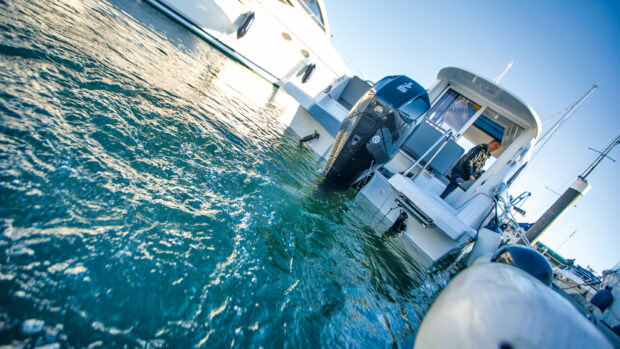The first choice to make when arriving at a berth in a single-engine boat is whether to go in bow or stern first. Boat training instructor Jon Mendez shows us how it's done...
Bow-in is usually simpler, however, best practice is to leave the boat as you found it, which in this case was stern-in.
As a stiff wind is blowing across the aisle in this example, there are two crucial points to get right to avoid hitting the boats downwind. The first is the turn into the aisle, as that tailwind will increase any momentum carried into the turn.
The second is knowing when to turn downwind before entering the berth. Both manoeuvres will take you towards the craft on the other side of the aisle, so the key things to focus on are:
- Using the helm and gears positively to balance the boat against the elements before making either manoeuvre.
- Keeping over to the windward side prior to making both manouevres.
- Leaving the final turn until the bow is level with the centre of the berth.
Many skippers fail to realise how much momentum the boat gathers from the elements alone. They go into neutral on the approach to the aisle but then fail to check how fast they are still moving. This means their turn into the aisle is accompanied by a slide towards danger.
The key is to fully stop the boat using astern gear and transits to check you’re not moving. To make the turn itself, use helm hard to port and ahead to drive into the aisle. Keep going all the way round until your bow is on the windward side of the aisle then slowly crab along at an angle with your bow pointing slightly upwind.
As the bow passes your berth, turn to starboard so it ends up on the downwind side just past the berth. Go as close as you dare to the boats on the other side of the aisle but make sure you leave enough room to stop. This also brings the stern to port and closer to the berth.
Article continues below…

VIDEO: How To – Leave a berth using springs

How to leave a berth safely in a single-engined boat
Now put the wheel to port and the engine astern to bring the stern up to windward and towards the berth. Use enough astern and wheel so that you end up balanced stern to the wind. If you have a bow thruster you can use small bursts to keep the bow where you need it – don’t use long bursts as that will skew the stern the other way and cause more problems.
Now using clicks of astern and wheel to suit, move the boat in small steps back into its berth. When fully in, kill any astern motion with a click of ahead. Put the stern line on first to stop any forward motion before securing the rest.
If you find the boat gets blown off before you can get the bow line on, return to the helm and engage ahead with the helm straight. This will bring the bow in and hold the boat nicely against the pontoon. Too much helm towards the pontoon forces the stern out and makes getting back off harder. Once the bow line is on, go into neutral and add the springs.
MBY’s How To video series is brought to you in association with GJW Direct.











